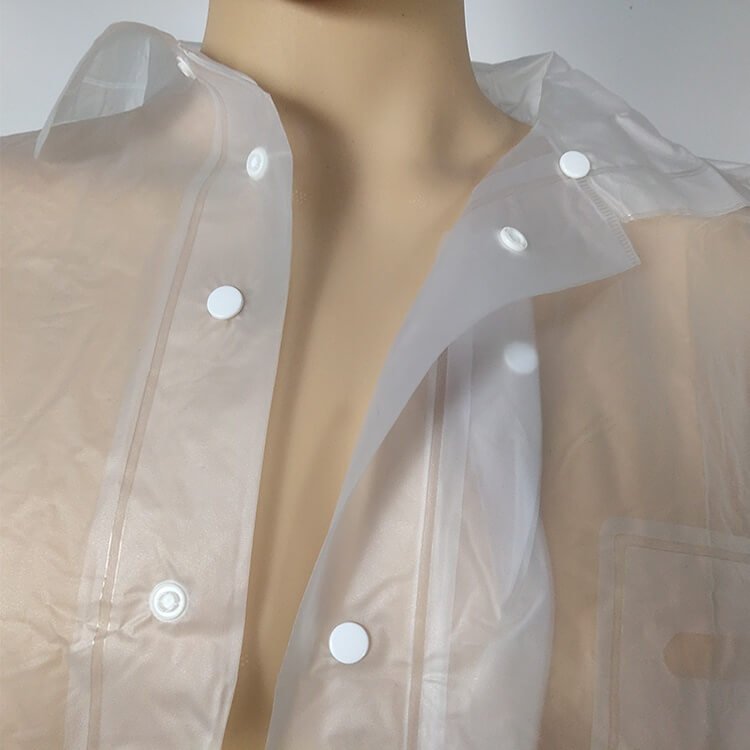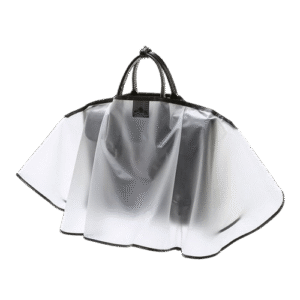When traveling in the rainy season, clear raincoats have become the choice of more and more people due to their unique advantages. Not only can they effectively resist wind and rain, but they can also show a different fashion in the rain. This article introduces the materials, purchase, and maintenance methods of clear raincoats, so that we can find the most suitable one.
1. What is a Clear Raincoat?
Clear raincoat is a waterproof outerwear made of transparent or translucent materials, such as EVA, PVC or TPU, to keep out the rain while maintaining visibility and a modern aesthetic. These materials are lightweight, durable, flexible and waterproof, and are no different from traditional raincoats, but their clear properties make them more popular in daily life and fashion.
2. What Materials are Clear Raincoats Made of?
PVC: This is the most common clear raincoat material, with high transparency and waterproofness, and affordable price. However, PVC needs to add plasticizers and other chemicals, which may release harmful substances after long-term use, and its flexibility and durability are relatively weak, and it is easy to harden at low temperatures.
TPU: TPU is an environmentally friendly elastomer with high transparency, wear resistance, tear resistance, good flexibility and breathability, and it is not easy to get stuffy when worn for a long time. It has outstanding cold resistance (still elastic at -35℃), suitable for outdoor scenes, and high color brightness, which can achieve diversified designs.
EVA: EVA material is soft and light, with strong waterproofness, and is often used in disposable clear raincoats. It has a low price, but poor breathability, and may produce a stuffy feeling after long-term use, and its durability is slightly inferior to TPU.
Silicone: Silicone is usually used as an auxiliary material. For example, in a transparent head cover helmet raincoat, the front solid plate is made of silicone material to enhance support and comfort. Silicone itself is non-toxic, high temperature resistant, and anti-aging, but because of its high cost and difficulty in processing, it is rarely used alone as the main material of raincoats.
Degradable plastics: For example, corn starch extracts, which can be naturally degraded in 180 days, but have poor waterproof durability. The disadvantage is that they are expensive and are currently mostly used in niche environmentally friendly brands.
| Material | Water Resistance | Environmental Friendliness | Softness | Durability |
|---|---|---|---|---|
| PVC | ★★★★☆ | ★★☆☆☆ | ★★☆☆☆ | ★★★☆☆ |
| TPU | ★★★★★ | ★★★☆☆ | ★★★☆☆ | ★★★★★ |
| EVA | ★★★☆☆ | ★★★☆☆ | ★★★★☆ | ★★☆☆☆ |
| SILICONE | ★★★★★ | ★★★★☆ | ★★★★★ | ★★★★☆ |
| Degradable Plastic | ★★★☆☆ | ★★★★★ | ★★★☆☆ | ★★☆☆☆ |
3. Advantages and Disadvantages of Clear Raincoats
Advantages:
Strong practicality: commonly made of PVC, TPU and other materials, weighing only 200-300 grams, folded into a small volume like an umbrella, can be easily stored in a bag.
Basic waterproof: effective in dealing with light and medium rain, protecting clothes from getting wet or stained with petals and mud.
Safety: children’s models are often equipped with clear brims + reflective strips to improve visibility in rainy days; adult long models can cover the whole body and prevent trouser legs from getting wet when riding.
No style restrictions: The transparent property makes it suitable for any color and style of inner wear, avoiding the style conflict of traditional raincoats.
Disadvantages:
Easy to break: Thin plastic materials (especially PVC) are easily scratched by branches and sharp objects, and cracks are easily formed after multiple folding.
Poor breathability: Most materials are not breathable, and it is easy to get hot and sweaty after exercise.
Weak protection against heavy rain: The joints are prone to water seepage during heavy rain, and the thin ones have insufficient waterproof pressure.
4. Scope of Use of Clear Raincoats
• Daily commuting, outdoor activities
• Street photography, stage shows (clear raincoats for cheerleaders)
• Scenic area emergency raincoats
• Pet raincoat (dog clear raincoat)
• Student activity raincoats
• Promotional gifts
5. How to Clean/Care for Clear Raincoats?



• Daily cleaning:
Applicable to rainy days, with water stains or slight dust on the surface:
Tools: wet towel or sponge
Steps:
- Gently wipe the surface of the transparent raincoat with a wet towel to remove mud, raindrops and dust.
- After wiping, wipe it with a dry towel and let it dry naturally.
• Deep cleaning (stains or odors)
Applicable to mud, oil stains or long-term uncleaning:
Steps:
- Soak the entire raincoat with cold water (not hot water)
- Use a neutral detergent (such as dishwashing liquid, mild laundry detergent)
- Gently wipe the stained area with a soft brush or cloth
- Rinse clean to ensure that there is no residual detergent
- Hang it in a ventilated and cool place to dry naturally
Note: Avoid using detergents containing bleach or strong alkaline to prevent damage to the material or make the raincoat yellow and brittle.
⚠︎ Transparent raincoat maintenance
⚠︎ Avoid direct sunlight
⚠︎ Do not fold and compress for storage
⚠︎ Avoid high temperature
⚠︎ Keep away from sharp objects
6. Wholesale/Purchase of Clear Raincoats
As a Chinese raincoat factory with more than ten years of experience, Shieldrain is confident that we can provide customers with quality products and services. We have BSCI, ISO and other certificates, and more than 200 employees are continuously supplying. We are located in Jiangxi, China, and have certain advantages in price and materials. Welcome to contact us.
Summary
In the case of light or medium rain, transparent raincoats are very suitable for wearing. Of course, we’d better choose breathable and durable materials. And transparent raincoats have become a new trend of daily wear. In the future, more and more people may try to accept it.
If you have any questions about transparent raincoats, please contact us and we will respond within 24 hours.







